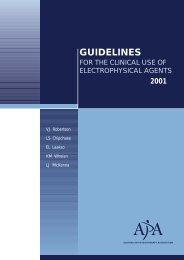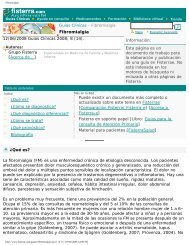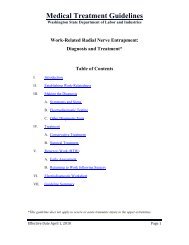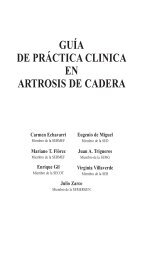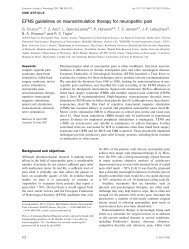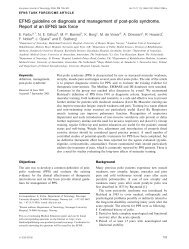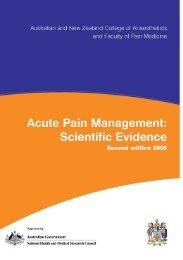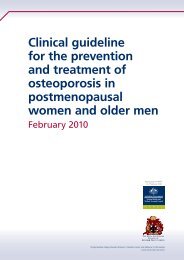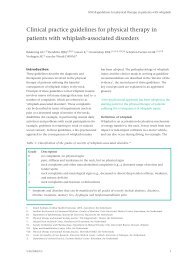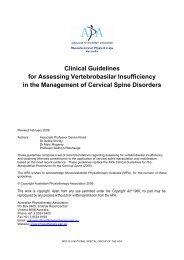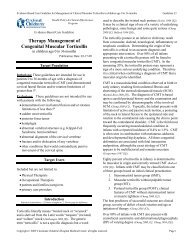Practice Parameter and Literature Review of the Usefulness of ...
Practice Parameter and Literature Review of the Usefulness of ...
Practice Parameter and Literature Review of the Usefulness of ...
Create successful ePaper yourself
Turn your PDF publications into a flip-book with our unique Google optimized e-Paper software.
Table 1. Comparison <strong>of</strong> pooled sensitivities <strong>and</strong> specificities <strong>of</strong> EDX techniques to diagnose CTS.TechniquePooledsensitivity*Pooledspecificity*ABMedian sensory <strong>and</strong> mixed nerve conduction: wrist <strong>and</strong> palm segmentcompared to forearm or digit segmentComparison <strong>of</strong> median <strong>and</strong> ulnar sensory conduction between wrist <strong>and</strong>ring finger0.85 †(0.83, 0.88)0.85(0.80, 0.90)C Median sensory <strong>and</strong> mixed nerve conduction between wrist <strong>and</strong> palm 0.74 †DComparison <strong>of</strong> median <strong>and</strong> ulnar mixed nerve conduction between wrist<strong>and</strong> palm(0.71, 0.76)0.71(0.65, 0.77)E Median motor nerve conduction between wrist <strong>and</strong> palm 0.69 †FComparison <strong>of</strong> median <strong>and</strong> radial sensory conduction between wrist <strong>and</strong>thumb(0.64, 0.74)0.65(0.60, 0.71)G Median sensory nerve conduction between wrist <strong>and</strong> digit 0.65 †(0.63, 0.67)H Median motor nerve distal latency 0.63 †(0.61, 0.65)I Median motor nerve terminal latency index 0.62 †JComparison <strong>of</strong> median motor nerve distal latency (second lumbrical) to <strong>the</strong>ulnar motor nerve distal latency (second interossei)(0.54, 0.70)0.56 ‡(0.46, 0.66)K Sympa<strong>the</strong>tic skin response 0.04(0.00, 0.08)0.98 †(0.94, 1.00)0.97(0.91, 0.99)0.97 †(0.95, 0.99)0.97(0.91, 0.99)0.98 †(0.93, 0.99)0.99(0.96, 1.00)0.98 †(0.97, 0.99)0.98 †(0.96, 0.99)0.94 †(0.87, 0.97)0.98 ‡(0.90, 1.00)0.52(0.44, 0.61)*For each EDX technique to summarize results across studies, sensitivities were pooled from individual studies by calculating a weighted average. Incalculating <strong>the</strong> weighted average, studies enrolling more patients received more weight than studies enrolling fewer patients. Specificities weresimilarly pooled by calculating <strong>the</strong> weighted average. The data in <strong>the</strong> paren<strong>the</strong>ses below <strong>the</strong> sensitivity <strong>and</strong> specificity values represent <strong>the</strong> lower <strong>and</strong>upper 95% confidence limits <strong>of</strong> <strong>the</strong> weighted average, respectively. Data analysis courtesy <strong>of</strong> Dr. Gary Gronseth. †There was heterogeneity betweensome <strong>of</strong> <strong>the</strong> studies (<strong>the</strong> 95% confidence intervals <strong>of</strong> <strong>the</strong> sensitivities <strong>and</strong> specificities do not overlap). This disparity may be related to differences incase definition <strong>of</strong> CTS, <strong>the</strong> use <strong>of</strong> different cut-points to define an abnormal value, <strong>and</strong> differences in <strong>the</strong> average severity <strong>of</strong> <strong>the</strong> CTS patients in <strong>the</strong>different studies. ‡Results based on a single study.RECOMMENDATIONS REGARDING EDX STUDIES TOCONFIRM A CLINICAL DIAGNOSIS OF CTSThe recommendations below are identical to thosemade <strong>and</strong> endorsed in 1993 by <strong>the</strong> AmericanAcademy <strong>of</strong> Neurology, 3 <strong>the</strong> American Academy<strong>of</strong> Physical Medicine <strong>and</strong> Rehabilitation, 4 <strong>and</strong> <strong>the</strong>American Association <strong>of</strong> ElectrodiagnosticMedicine 5 with <strong>the</strong> clarification <strong>of</strong>recommendation 1 <strong>and</strong> 2a <strong>and</strong> <strong>the</strong> addition <strong>of</strong> 2cbased on new evidence reviewed in <strong>the</strong> secondCTS <strong>Literature</strong> <strong>Review</strong>. 2In patients suspected <strong>of</strong> CTS, <strong>the</strong> following EDXstudies are recommended (See Table I forsensitivity <strong>and</strong> specificity <strong>of</strong> Techniques A–K):1. Perform a median sensory NCS across <strong>the</strong>wrist with a conduction distance <strong>of</strong> 13 cm to14 cm (Technique G). If <strong>the</strong> result isabnormal, comparison <strong>of</strong> <strong>the</strong> result <strong>of</strong> <strong>the</strong>median sensory NCS to <strong>the</strong> result <strong>of</strong> a sensoryNCS <strong>of</strong> one o<strong>the</strong>r adjacent sensory nerve in<strong>the</strong> symptomatic limb (St<strong>and</strong>ard).2. If <strong>the</strong> initial median sensory NCS across <strong>the</strong>wrist has a conduction distance greater than 8cm <strong>and</strong> <strong>the</strong> result is normal, one <strong>of</strong> <strong>the</strong>following additional studies is recommended:a. comparison <strong>of</strong> median sensory or mixednerve conduction across <strong>the</strong> wrist over ashort (7 cm to 8 cm) conduction distance(Technique C) with ulnar sensory nerveconduction across <strong>the</strong> wrist over <strong>the</strong> sameshort (7 cm to 8 cm) conduction distance(Technique D) (St<strong>and</strong>ard), orb. comparison <strong>of</strong> median sensory conductionacross <strong>the</strong> wrist with radial or ulnarsensory conduction across <strong>the</strong> wrist in <strong>the</strong>same limb (Techniques B <strong>and</strong> F)(St<strong>and</strong>ard), orc. comparison <strong>of</strong> median sensory or mixednerve conduction through <strong>the</strong> carpaltunnel to sensory or mixed NCSs <strong>of</strong>proximal (forearm) or distal (digit)AAEM <strong>Practice</strong> Topic MUSCLE & NERVE June 2002 921



